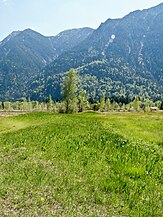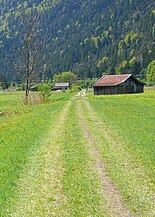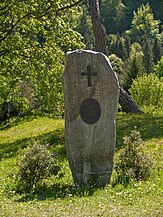Entrance facilities at Farchant
The ski jump facilities at Farchant consist of two ski jumps between Farchant and Oberau in the Garmisch-Partenkirchen district in Upper Bavaria . In the years 1646-1648 by the county Werdenfels built "Schwedenschanze" should the attacking from the north Sweden deter the Werdenfelser country to pillage , while in the years 1702/1703 from the Duchy of Bavaria built "New Schanz" should prevent that imperial troops advancing from the south occupied Bavarian territory. The jumps are ground monuments on the basis of the Monument Protection Act of October 1, 1973 . The Schwedenschanze has the monument number D-1-8432-0009 and the Neue Schanz the monument number D-1-8432-0008.
geography
The entrenchments are located on the former border of the County of Werdenfels, which belongs to the Principality of Freising, and the Electorate of Bavaria, between Farchant and Oberau. In the 17th and 18th centuries there was still the Farchanter Moos marshland north of Farchant, which filled the entire valley floor. This marshland was only cut through by the Loisach river and the road that led from the Werdenfelser into the Bavarian territory. The Steinerne Brückl , an arched stone bridge built at the beginning of the 16th century over the approximately five meter wide Ronetsbach, served as the border crossing . The bridge was demolished in autumn 1935 to make way for a new building. The older Schwedenschanze runs about 300 m north of the so-called Steinerner Brückl from Bundesstraße 2 to the east to the alluvial forests of the Loisach. It is about 500 m long. The newer Neue Schanz runs about 200 m west of the Ronetsbachbrücke from the mountain slope of the Schafkopf 900 m in a north-easterly direction to the point at which the Alte Schanze also reaches the alluvial forests of the Loisach. This jump leads on the eastern side of the Loisach about 450 m further to the Röhrlenbach and from there through today's golf course 250 m east to the mountain slopes of the Hohen Fricken .
history
Schwedenschanze
In 1632 the Thirty Years War also reached the Bavarian Oberland . In order not to fall into the hands of the Swedes, the Freising Prince-Bishop Veit Adam fled first to the County of Werdenfels, which belonged to the Prince-Bishopric of Freising, and then on to San Candido in South Tyrol , which was also under Freising's rule. The Bishop's Chancellor , Dr. Plebst, negotiated a letter of protection with the advancing Swedes for 30,000 guilders , which was supposed to protect the Freising property. However, Kurbayern was at war with the Swedes, so that it was treason for the Bavarian Elector Maximilian . In retaliation, he attacked the royal seat of Freising on May 5, 1632 . The commander of the troops demanded an additional 5,000 guilders. Only one day later, the Swedish King Gustav II Adolf quartered on the Freising Cathedral Hill and marched into Munich on May 18th . Many villages in the Oberland went up in flames in the following time, Murnau was occupied by a Swedish cavalry detachment in May 1632 and was not burned down for a pillage of 300 guilders. After Oberammergau and Eschenlohe , the Swedes plundered Ettal in June 1632 . The Werdenfelser Land was spared. The county keeper nevertheless made the road at Steinernen Brückl impassable, although the withdrawal of the Swedes was already foreseeable.
In 1646 the war of the County of Werdenfels came threateningly close again, even the Tyrolean rulers demanded that a ski jump be built at Steinernen Brückl :
" " ... by means of an average from one to the other through the Farchanter moss .. to create a generally useful definition work. " "
After many diplomatic discussions and correspondence, Tyrol, Bavaria and Freising finally agreed in November 1646 to build the ski jump at Steinernen Brückl . Construction began immediately, but had to be stopped a short time later due to the approaching winter. In 1647 the project was pursued with less zeal, since the theaters of war had receded, Werdenfels was spared again. When things got threatening again in the spring of 1648, the Freising people ordered the ski jump to be completed as soon as possible. This succeeded until the end of April, and the Werdenfels keeper had riflemen set up as guards at the ski jump and water was channeled into the trenches. The Thirty Years War ended on October 24, 1648 with the Peace of Westphalia , and the County of Werdenfels did not have to repel a single attack by the Swedes during the 30-year war.
New Schanz
The county of Werdenfels was between the fronts of the Habsburgs and Wittelsbachers during the War of the Spanish Succession . The Freising Prince-Bishop Johann Franz tried to be neutral in this confrontation, and he instructed the Werdenfelser Pfleger to maintain a good neighborly relationship with the Tyroleans as well as with the spa Bavarians. When the conflict threatened to escalate in the Loisach Valley in 1702 , the Bavarians began again with work on a hill in the area around the Steinerne Brückl , this time to be able to repel possible attacks by the Austrians from the south. Shortly before Christmas, the palisade wall with a moat could be completed. This hill stretched over the whole valley, only interrupted by the Loisach, and was about 1.6 km long in total.
On August 27, 1703, the so-called Battle of Steinernen Brückl took place at the hill . About 11,000 Austrian and Tyrolean troops held the Werdenfelser Land. The Bavarian troops were in retreat, and only 900 men held the position at the hill. The Bavarians had no chance against the 8,000 strong superior force of the imperial, so that after four hours of fighting, the electoral captain Berdo with his officers and 60 soldiers had to surrender to the Austrians.
Web links
- Consecration of the memorial stone at the Schanz. In: www.gaponline.de. Retrieved May 4, 2011 .
- Club chronicle 1700 - 1816. In: Abensberg Fire Protection Society. Retrieved May 4, 2011 .
Individual evidence
- ↑ Schwedenschanze. Bavarian State Office for Monument Preservation, accessed on May 2, 2011 .
- ↑ New Schanz. Bavarian State Office for Monument Preservation, accessed on May 2, 2011 .
- ^ Heinrich Spichtinger: Das Steinerne Brückl . In: forcheida - Contributions from the Farchanter Heimatverein . No. 16 . self-published, Farchant 2010, p. 20-23 .
- ↑ Josef Brandner: Around the Landl . Adam-Verlag, Garmisch-Partenkirchen 1993, 200 muskets for national defense, p. 167-168 .
- ↑ Hochstiftsliteralien von Freising . Main State Archives, Munich (Abh. 2, No. 62f).
- ↑ Josef Brandner: Around the Landl . Adam-Verlag, Garmisch-Partenkirchen 1993, The Schwedenschanze from 1648, p. 168 f .
- ↑ Josef Brandner: Around the Landl . Adam-Verlag, Garmisch-Partenkirchen 1993, Habsburg versus Wittelsbach, p. 171-172 .
- ↑ Josef Brandner: Around the Landl . Adam-Verlag, Garmisch-Partenkirchen 1993, Die Schlacht am Steinernen Brückl, p. 172-174 .
Coordinates: 47 ° 32 '46 " N , 11 ° 7' 35.3" E





